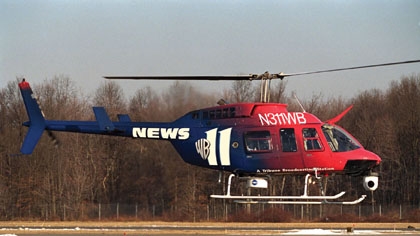WPIX-TV's digital helicopter

A helicopter is a hostile environment for COFDM transmission.
It sounds too good to be true: a noise-free digital microwave link for audio and video transmission, using less than half the bandwidth and power of current analog FM technology. How about increased range, an extra stereo audio and data channel, and the transport of digital signals without passing through an NTSC conversion? Even better, almost complete immunity from multipath distortion, with a transmission scheme that seems to thrive on random, reflected bits of signal bounce. For WPIX-TV, in the heart of New York City, the last consideration is an important one; live shots bounce like billiard balls cascading their way to our receive antennas. Now add features such as stable mobile transmission even while driving through (or flying above) the deep RF canyons of Manhattan. This is a news director's dream.
So when it was time for a news helicopter for our new morning show, the WB11 Morning News, we chose a digital COFDM system. Conventional news helicopters are outfitted with a standard FM analog microwave transmitter. Fading, breakup, audio and video noise, limited picture quality and multipath reception problems (ghosting) are all too common. Signals bouncing off reflective surfaces like buildings or mountains cause multipath problems that come in two flavors: static and dynamic. Static multipath interference can be observed when transmitting from a fixed location; bounced signals arrive at the receive antenna a little later than the main signal. This often causes video ghosting, chroma smear, changing hues and audio buzz that can seriously degrade live shots. Microwave transmission from a moving source can be particularly susceptible to dynamic multipath interference, characterized by signal dropouts, moving multiple ghosts, and severe chroma and audio noise fluctuations. COFDM systems thrive on these reflections, adding thousands of QPSK carrier signals back together, utilizing sophisticated forward error-correction algorithms. They basically “eat” the reflections and spit out good signal. Also, current plans by the FCC call for a substantial bandwidth reduction in the 2GHz microwave news band currently used by broadcasters. Looking forward to this eventuality, digital COFDM microwave radios may provide us with a technology that would at least equal the performance of analog systems in this regard. This was an important consideration for us, as was the concept of delivering SDI (and HD in the future) digital streams intact back to the studio. Of course, with these benefits there is the downside of significant processing delay.
After leasing a Bell “Long Ranger” helicopter from Helinet, Inc., in Los Angeles, we sent it to Wysong Enterprises in Tennessee for integration. Although the avionics package was fairly standard, there was special consideration for our all-digital design plans. Early on we realized that one of the main disadvantages of both the compression and modulation schemes used in digital microwave is its inherent latency. The digital stream may exhibit a delay of anywhere from 20 milliseconds up to two seconds. This means that the talent needs a “mix minus” IFB system; returning program audio should omit the talent's voice to enable chatter with the studio anchors. First, we installed a Modulation Sciences Pro Channel audio modulator into our VHF channel 11 transmitter atop the World Trade Center, enabling the broadcasting of a discrete audio subcarrier to Pro Channel receivers. We then purchased their receive system, which includes reception of conventional off-air video and audio, and installed it in the helicopter for monitoring and IFB. Although talking back and forth to the studio still presents a challenge to the talent, it is somewhat mitigated by this technique.
Next was our choice of a camera. A long lens, a stable gyro system and SDI output were all specified and resulted in the purchase of an Ultramedia III camera ball from Flir Systems. It combines a Sony BVP-570 camera with a Canon 1000mm lens and has the optics and imaging devices mounted in a remote-controlled pod under the nose of the helicopter. The CCU has an SDI output that goes directly into a custom-designed Sony serial digital program switcher. The addition of two Toshiba talent cameras inside, three Sony POV cameras outside the craft and a portable Sony Digital Betacam VCR rounded out our major video system acquisitions. The smaller cameras are converted to SDI and routed to the switcher.
Tandberg was our choice for MPEG compression and COFDM modulation hardware. Its 5100 encoder system, soon to be upgraded to the smaller model 6100, provides source and channel coding in one DC-powered device. The SDI digital signal is fed into the Tandberg, where different compression algorithms may be selected, giving the ability to trade off delay for robustness. This needs to be tweaked for best signal stability vs. noticeable audio/video time delay, but no actual lip sync problems have ever been experienced. The Tandberg modulator has a 70MHz IF output that goes to the digital input of the transmitter.
The microwave transmitter chosen was the Nucomm PT-6 digital radio. It is a compact, high-powered unit that provides a full 12W in analog mode, or approximately 8W in digital. The remote control unit offers a choice of analog or digital modulation, channel assignment and power level. A Nucomm microwave receiver and downlook antenna also were added for receiving ground-based signals. A helicopter is a hostile environment for COFDM transmission. Vibration alone is a major problem for attaining the degree of stability required to pass the digital signal through the front end of the radio. Phase noise and even very slight frequency instabilities are the bane of COFDM transmission. The same is true at the receiving end, where completely redesigned ultra-stable Nucomm CR-6 digital central receivers were installed. Each receiver feeds a 70MHz IF signal into a Tandberg Alteia COFDM decoder and, from there, both SDI and analog NTSC signals are fed back to the station.
The professional video industry's #1 source for news, trends and product and tech information. Sign up below.
The transmit antenna system is from N Systems (NSI) and consists of a steerable high-gain pod antenna or an omni antenna, switchable from the transmitter remote control. A GPS satellite receiver with our receive sites programmed into it, and a flux gate compass to determine heading of the craft, each pass their signals to an onboard computer. The signals are compared and the Superpod is driven to automatically point at the chosen receive site. In addition, the NSI computer sends telemetry signals to the Superquad receive antenna system, pointing the dish at the receive site automatically at the helicopter. This is all tied into the NSI MC5 Pro control system, so once the microwave receive technician in the studio begins to acquire a signal from the helicopter, both antennas “lock” on to each other. This works well in both analog and digital modes of operation.
The results? The helicopter was finished just in time for the debut of our morning news show in June 2000 and we flew it from Tennessee to New York. It took until February 2001, however, for full-time digital transmission to begin. When the final bugs were fixed, and the latest versions of equipment were installed, we flew a test flight during the morning show. We expected some improvements, but nothing prepared us for the outcome. The camera produced digital pictures that were clear even to the untrained eye.
I joined the crew for the final test flight to the south to see what our final range would really be. We headed past Atlantic City, about 90 miles out, and continued south. At 110 miles, we climbed to 2500 feet, and the pictures back still looked perfect. Finally, at an altitude of 3000 feet we sent back pictures of the Cape May water tower from a distance of 125 statute miles before running out of signal.
Finally, while the digital COFDM system requires less bandwidth than the current analog one (8MHz vs. 17MHz), we look forward to further refinements that will alleviate the shrinking of an already congested ENG band. Future channel bandwidths of as little as 6MHz will help maintain parity with the current allotment of news microwave frequencies, while retaining the spacing between them. These improvements, along with reduced size, weight and, of course price, will be the icing on the digital cake.
Ralph Augenfeld is the engineering manager for WPIX-TV, WB11, in New York, NY.
